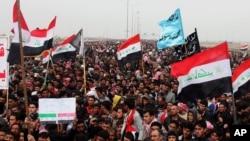The Sunni-Shi’ite divide playing out in violence in parts of the Middle East is an ancient dispute that traces back to the dawn of Islam.
It started some 1,400 years ago with a dispute over leadership for the Muslim community following the death of the Prophet Mohammad.
“There were those who felt that the leadership should fall upon the most able individual,” said Gregory Gause, a professor at the International Affairs Department at Texas A&M University. “These people came to be known as Sunnis because they followed the Sunna, or the way of the prophet.
“There were those who felt that the leadership should remain within the blood relatives of the prophet,” he said. “These people focused on Ali; the prophet’s cousin and they became known as the Shi’ite or ‘partisans of Ali.”’
Through the centuries, there have been periods when Sunni and Shi’ite Muslims managed to live peacefully together despite their ancient religious divide. But rivalries persisted and shaped the Middle East.
“Sunni Muslims dominated the first nine centuries of Islam until Persia made Islam the state religion in the 16th century and fought the Ottomans; the seat of the Sunni caliphate,” said Bruce Hoffman, director of Center for Peace and Security at Georgetown University.
In recent years, violent sectarian conflict has marked their shaky relationship.
“In Syria and Iraq, with the collapse of centralized authority, we have seen the resurgence of sectarian identity, in Bahrain the state has not collapsed but a Sunni family is ruling a Shi’ite majority population,” Gause said.
Gause said that in other parts of the Middle East - like Lebanon - there is a history of a divided population on a sectarian basis since its independence and the political system assigns specific public offices based on sectarianism which further the divide.
Hoffman, said modern tensions have their roots in rising intolerance on one side toward a different religion or point of view.
“It leaves no room for reasoning or coexistence,” he said. “That is why minorities became increasingly at risk - whether Shi’ite in majority Sunni countries or Sunni minorities in majority Shi’ite countries.”
Growing sectarian clashes in Syria and Iraq have produced a revival of transnational terrorist networks that attracted tens of thousands of local and foreign militant fighters, analysts say.
Gause said the militant movement known as the Islamic State in Iraq and Syria expanded its grip on Sunni provinces in Iraq and eastern regions in Syria by exploiting the vacuum left by the collapse of state authority in Syria and the politics of exclusion in Iraq.
“Wherever you have ungoverned territories, you have an opening for jihadi and terrorist groups to establish base and function,” he said. “The collapse of state authority has also opened up arenas for Iran, Saudi Arabia, Turkey, Qatar, and Israel to attempt to affect the domestic political conflicts.”
Sunni-Shi’ite tension is creating multiple threats not only on a local level but also to international peace and security, analysts say.
“This tension is a challenge to the concept of the nation state in Lebanon, Syria, Iraq, Bahrain, and Yemen,” Gause said. “It is entirely possible that we are going to see weak states, with divided authorities in the eastern Arab world for some time.”
Experts say the sectarian conflicts in Syria and Iraq is threatening to redraw the map of the Middle East, creating fractured states and displacing millions of civilians causing humanitarian crisis.
The American Federal Bureau of Investigation director James Comey warned recently that thousands of foreign fighters from Europe and the U.S. who were attracted to fight in the war in Syria are posing a long-term threat to Western interests because they create a potential “terrorist diaspora”.
“What we see in Syria is the creation of a safe haven, a training ground, and potentially a launching ground for terrorists,” he said.
In recent weeks, U.S. forces have become involved in the fight, using air strikes to curb militants of the Islamic State in Iraq and to help a tide of refugees spawned by the militants violent assaults on parts of Iraq.
Following the beheading of a U.S. journalist by members of the Islamic State in Syria in apparent retaliation for the U.S. strikes, President Barack Obama equated the Islamic State with cancer "whose spread must be contained.”
“It has and will continue to torture and kill civilians, massacre religious minorities, and rape women,” he said.
James Jeffrey, a former U.S. ambassador to Iraq, said the Islamic State militants are difficult to contain because their support is based on a flow of funds and volunteers from the Islamic world. He said that the only option is for the Obama administration to lead a fight against the Islamic state.
“The U.S has to form a three-way coalition of peoples in the region who are willing to rise up against ISIS and there are many Sunni Arabs who are fighting against ISIS,” he said, using the acronym for the Islamic state.
Jeffrey added that the coalition would include an upgraded Iraqi army and the support of U.S. forces with airstrikes and training and equipment for an international effort to curb the militants.








